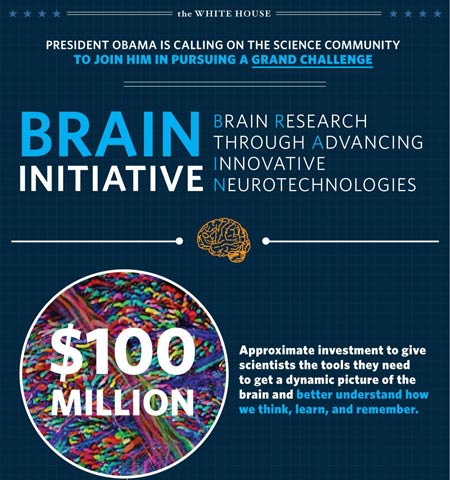AARP Eye Center
The BRAIN Initiative: 5 Things to Noodle
By Steve Mencher, April 2, 2013 02:59 PM
In 1961, President John F. Kennedy called on the nation to set as its goal " landing a man on the moon and returning him safely to the earth" by the end of the decade.
Today, President Barack Obama called on the nation to set a similarly ambitious goal: mapping the human brain to unlock the answers to Alzheimer's disease.
"We can study particles smaller than an atom, but we still haven't unlocked the mystery of the three pounds of matter that sits between our ears," Obama said in announcing the $100 million initiative that his administration has dubbed BRAIN (for Brain Research through Advancing Innovative Neurotechnologies). It's an idea that he previewed on Feb. 13 in his State of the Union message.

Here are five things to know about the BRAIN initiative:
- It's not just about Alzheimer's. In his remarks at the White House, Obama said that $100 million initiative will also seek to find new answers for Parkinson's disease, autism, stroke, post-traumatic stress disorder (PTSD) and the control of prosthetic limbs.
- It aims to "boldly go where no man [or woman] has gone before." In an article published last year in the journal Neuron, some of the scientists involved in the BRAIN initiative put it this way: "Understanding how the brain works is arguably one of the greatest scientific challenges of our time. Although there have been piecemeal efforts to explain how different brain regions operate, no general theory of brain function is universally accepted. A fundamental underlying limitation is our ignorance of the brain's microcircuitry, the synaptic connections contained within any given brain area, which [one researcher] referred to as 'impenetrable jungles where many investigators have lost themselves.'"
- It's something new and something old. In true Washington fashion, it will all start with a commission - in this case, a "working group" that will be headed by Cornelia "Cori" Bargmann, a neurobiologist at Rockefeller University, and William Newsome, a neuroscientist at Stanford University.
- It's a public-private partnership. On the public side, three federal entities - the National Institutes of Health, the Defense Advanced Research Projects Agency and the National Science Foundation - will oversee the initiative. On the private side, the nonprofit partners include the Allen Institute for Brain Science (founded by Microsoft cofounder Paul Allen), the Howard Hughes Medical Institute, the Kavli Foundation, and the Salk Institute for Biological Studies.
- It promises a good ROI. The government can't announce any science-based initiative, it seems, without claiming that it will have a strongly beneficial effect on the economy. In this case, the White House invoked the initiative's genomic forebear: "From 1988 to 2003, the federal government invested $3.8 billion in the Human Genome Project, which has since generated an economic output of $796 billion - a return of $141 for every $1 invested." There's no footnote, but you can follow the money here and judge for yourself.
Francis S. Collins, the director of the National Institutes of Health, introduces BRAIN in 60 seconds:
Also of Interest
- Valerie Harper's Rare Brain Cancer: What Caused It?
- Colonoscopies and Seniors: What to do?
- Join AARP: Savings, resources and news for your well-being
See the AARP home page for deals, savings tips, trivia and more























































